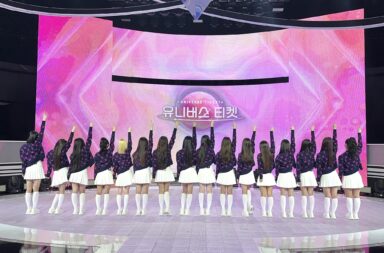Disclaimer: This review contains spoilers, although you will find out quickly there’s not much to spoil for this show. At time of publishing, public voting for the top 8 (40%) has already closed but the final crew after considering judges’ votes (60%) has not yet been announced.
Considering the current K-pop’s generation’s emphasis on dance, aided by the wide reach of TikTok, Mnet dance survival show Street Woman Fighter’s (SWF) global success last year shouldn’t be a big surprise. The dance crew members have since infiltrated the mainstream, landing individual gigs, brand deals, and collaborations with K-pop artists. The spotlight is on the rising South Korean dance community, more than ever before.

For better or worse, Mnet’s tradition of announcing a male equivalent of their female-led programmes followed soon after, and Street Man Fighter (SMF) was announced for mid 2022. In a Road to Kingdom style, a prequel programme Be Mbitious was also announced, with the end goal of forming a dance crew that would compete on the main show. Over 400 male dancers across South Korea without a crew responded to the open call for audition clips, dancing to the show’s theme song, “SMF” by Changmo. The aggressive-sounding earworm by the trendy rapper is exactly what one would expect from the programme, and it does an excellent job at setting the tone for the testerone-fuelled event that was to come.
All the audition clips were posted on the participants’ personal social media pages, as well as on Mnet’s new YouTube channel The Choom, signalling Mnet’s long-term intention to capitalise on the current popularity of dance-centric programmes and content. Amongst the auditionees were a number of idols, such as former B.A.P members Zelo and Jongup, former Infinite member Hoya, former Hotshot and JBJ member Taehyun, Produce X 101 alumni Baekjin, former TST member Ain, KARD’s BM, Pentagon’s Kino, ONF‘s U and three members of DKB (Heechan, Junseo, Harry June). Even without watching the show, you can already imagine the age-old beef of “idols vs dancers” being milked to its last drop, as eyeroll-inducing as it has always been.
Few details about Be Mbitious were released until nearly two weeks before it was due to air, foreshadowing the rushed, ill-planned out show. It ended up spanning over a draggy airtime of six hours across just three episodes. Just 40 participants were shortlisted from all the audition clips for the 48-hour bootcamp-style programme which consisted of mainly two parts — a choreography-copying challenge and a 1-on-1 battle. By the end, only 20 would be shortlisted for a public vote, where the final 8 would form the project dance crew, Mbitious, for the main show in August. Despite aiming for the show to be global, with a rumored SMF tour in the later half of the year, it is worth noting that most of the show’s clips are region-locked for only Korean audiences, including the voting for the top 8.
The first challenge is to copy the choreography to SWF’s version of “Hey Mama”. Noze shows up to perform her viral choreography, and she does a commendable job at pretending she’s not sick of performing it countless times the past year. The contestants are confident, sharing that they expected this, or have already learnt the choreography. But their hopes are quickly dashed when Noze reveals that the actual challenge is to learn HolyBang’s and La Chica’s versions in 3 hours instead. To the horror of the group of 40 grown men, HolyBang’s choreography is a groovier, hip-hop piece, but La Chica’s leans towards female-style hip-hop.
Of course, this is met by non-stop complaints and overreactions from many participants, most of whom specialise in the more male-dominated genres of hip-hop, locking, popping, and house. It was portrayed in a light-hearted way, but it also really gets you wondering: how outrageous is it really to expect a group of supposedly professional-level dancers to use their hips and butt for a dance? Nonetheless, it is undoubtedly fun to laugh along and at the contestants giggling childishly and feeling hopeless just from being made to do a dance genre they’re not familiar with. One even said he felt like his “whole career was a waste of time”.
The first 20 dancers to earn a “respect” sticker from both HolyBang and La Chica are given the advantage to choose their opponent for a 1-on-1 evaluation in the next round where the respect dancers teach a no respect dancer a choreography before competing in a freestyle battle. The winner of each 1-on-1 battle qualifies for the top 20.
Generally, the entire format of the show is flawed, as it ends up prioritising freestyle over choreography despite the nature of the main SMF show. Failure to perform well in round 1 is essentially inconsequential, while round 2 decides it all. Whether you make it to the top 20 has little to do if you’re actually in the stronger half of the competition, but whether your one opponent in round 2 is stronger or weaker than you. The result is an uneven standard in the top 20: weaker dancers cruise by with easier-to-beat opponents, and many strong dancers are left behind.
Shockingly, certain contestants also refused to learn choreography, insisting on freestyling their way through the programme. Some others walked around and taunted their opponent during the freestyle section without actually dancing much. The overall standard of dancing shown, along with these questionable attitudes and unwillingness to explore dance out of their comfort zone–how did they expect to get through the main SMF show?–raises the question of whether the selection of the top 40 were truly based on merit “selected by video screening and verification by professional judges”, or if they were just carefully chosen for entertainment purposes.
Rain adds a dash of celebrity-hype to the show as the emcee, but his presence is easily eclipsed by the enthusiasm and charisma of the SWF ladies, who make an appearance here not only as choreographers, but also as the judging panel. La Chica’s Gabe was a stand-out personality, adding a dash of fun and positive energy to the tension-filled room as she teaches the choreography to “Hey Mama”. The ladies add much-needed heart to the show, giving great advice, reactions, and encouragement to the participants.
Unfortunately, the same cannot be said for the quality of the judges’ evaluations shown, which were questionable to say the least. Famed K-pop choreographer Kiel Tutin and member of dance crew Royal Family joined the judging panel alongside the SWF cast and Rain. But he was not given enough screen time, especially considering how he gave one of the only few sensible inputs of the entire show during the deliberation between unknown Mongolian contestant Yamakasi and veteran battler Crazy Kyo. He mentioned that he was judging based on the performance shown in the current battle, instead of factoring in prior knowledge of the dancers’ existing credentials in the dance scene.
This objectivity was sorely lacking in the clips shown to audiences, where the judges were shown constantly mentioning entirely irrelevant facts, including their relationship to the contestants as their former students or teachers. These clips notably centred their evaluation and praise for certain contestants around their looks or physiques. As the show drones on battle after battle, the surprise factor eventually stems not from the performances, but the justifications for passing different contestants. These range from choosing high school student Jungwoo solely for his potential and “back story”–despite a weaker showing–to failing tutting legend Tutat because he was too good to the point of intimidating the other contestants. With any art form, there is no one correct way to judge, but way too many contestants were passed for every possible reason besides their actual showing in the challenges. At one point, a judge even said started her evaluation by saying “I tried to judge as fairly as possible but…”. Why was the qualifier “but” needed?
Of course, the benefit of the doubt must ultimately be given to the judging panel, whose comments and feedback could have been easily cherry-picked by Mnet’s production team for potential entertainment value, and to cater to general audiences with little dance knowledge. Nonetheless, it was a missed opportunity to showcase more nuanced and technical evaluations of dancing to wider audiences. Instead, the show popularises untrue facts about the relationship between dance genres and gender and overemphasises body types and physiques in dance. It also perpetuates the belief that confidence can or should triumph over very noticeable differences in technical dance ability in the context of a professional dance competition. Mnet also displayed a lack of knowledge towards different dance genres, such as when the two more effeminate-presenting contestants Bae Seungyoon and Xhin were lazily clumped together and pitted against each other in a segment featuring “girlish styles” when their styles aren’t similar. While Seungyoon specialises in female hip-hop, Xhin specialises in waacking, a genre that originated in gay discos rather than having anything specifically to do with women.
Here lies one of the main issues of Be Mbitious. Seeing as the entire programme was filmed under 2 days, the top 20 were already known long before the show aired. It’s understandable that they would have to give ample screen time to the top 20 so there would be content for viewers to base their votes on. But Mnet’s editors do a downright awful job at making it suspenseful regarding who eventually advances for the public evaluation, which basically sucks all fun out of watching a survival show. Time was spent to build up a “brand” for the top 20, whereas the eliminated 20 are erased, or evil-edited to be as unlikeable and cocky as possible in classic Mnet fashion to boost their winning counterparts. Of course, the show doesn’t leave out dramatising the pre-existing beef between former crew mates and estranged mentor and mentees too.
For those lacking basic media literacy or are new to Mnet’s tricks, this may still work. But for seasoned survival show programme viewers, it’s predictable and uninteresting. All this time building these storylines could have been spent showing better cuts of the contestants dancing, instead of messy, shaky camerawork and cuts that made the viewing experience frustrating and at times confusing.
Another issue is the inconsistency in screentime. Renowned K-pop choreographer Kasper was one of the most recognisable faces in the show. He was given much screen time to play up “idol vs dancer” drama with Pentagon’s Kino who “wants to break the stereotype”, but was not mentioned at all after the first episode. ONF’s main dancer U was one of the front runners of the show before its premiere because of his viral audition clip, and was featured heavily in the teasers where he was singled out and praised by multiple judges and contestants. But during the show, he was given close to no screentime until he was dealt with rather unfavourable cards that led to his eventual elimination. Interestingly, U has mentioned after the show that his audition clip ranked #1 amongst all 400+ submissions through a judges’ evaluation, a section that was teased at the start of the first episode, but was cut off awkwardly and eventually not aired at all.
The final 21 (thanks to a last wildcard inclusion) received fleshed-out storylines in the show for every cliched character prototype you could think of having on a dance programme. There is the humorous, class-clown locker BrotherBin with an influencer-level Instagram following, and the elite and feared Pyoungya who unexpectedly crumbles and cries under pressure in round 1, but makes an overdramatised comeback in round 2. There is also OhBody, the respected dance veteran in his 40s feeling the pressure to keep up with his more agile juniors. The buzzworthy Cha Hyunseung, who was known as Sunmi’s attractive dancer before he exploded with popularity as a contestant on hit Netflix dating reality show Single’s Inferno, somehow also beat the odds (prejudices from other contestants for being “just an influencer”) despite a mediocre showing in terms of dance.

Additionally, it seems as if no Mnet survival show is met without rigging accusations. Mnet has already had to release a statement and apology responding to the criticism about how some auditionees submitted clips of the same choreography and yet, were allowed into the top 40. The obvious favouritism in terms of screentime and angel or evil editing for differing contestants certainly do not help with the sentiments. The bottom line of this is clearly not to expect much reality with Be Mbitious. Rather than being a showcase opportunity for more unknown dancers to express their craft to a larger stage, it comes across much more like a huge PR opportunity for a selected few dancers. After all, despite suggesting that the final crew would be decided by a public vote, 60% of the scores still will end up being decided by Mnet’s internal A&R team.
The amount of pride and gusto makes Be Mbitious for a quality, light-hearted watch at times, but the contrived editing greatly cheapens the overall watching experience. For a show about dance, there’s strangely not enough of it. SMF airs in August, and hopefully a longer timeline, bigger budget, and higher stakes will lead to a more well-thought out show than this prequel.
With that, here are some quotes from the show, conveyed with a sense of bravado that perfectly capture the unintended humour of Be Mbitious.
“Be Mbitious respects all dancers and their ambitions.”
“It’s about men’s pride. I should do it like a man.”
“In Be Mbitious, it’s not about our age or rank. It’s about dance.”
(YouTube. Images via Mnet.)


